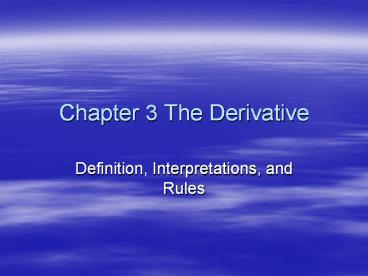Chapter 3 The Derivative - PowerPoint PPT Presentation
1 / 24
Title: Chapter 3 The Derivative
1
Chapter 3 The Derivative
- Definition, Interpretations, and Rules
2
Average Rate of Change
- For y f(x), the average rate of change from x
a to x ah is
3
Average Rate of Change, cont.
- Graphically, the average rate of change can be
interpreted as - the slope of the secant line to the graph through
the points (a, f(a)) and (ah, f(ah)).
4
Instantaneous Rate of Change
- If y f(x), the instantaneous rate of change at
x a is
5
The Derivative
- For y f(x), we define the derivative of f at x,
denoted f(x), to be
6
Interpretations of the Derivative
- The derivative of a function f is a new function
f. The derivative has various applications and
interpretations, including - 1. Slope of the Tangent Line to the graph of f
at the point (x, f(x)). - 2. Slope of the graph of f at the point (x,
f(x)) - 3. Instantaneous Rate of Change of y f(x) with
respect to x.
7
Differentiation
- The process of finding the derivative of a
function is called - differentiation.
- That is, the derivative of a function is obtained
by - differentiating the function.
8
Nonexistence of the Derivative
- The existence of a derivative at x a depends on
the existence of a limit at x a, that is, on
the existence of
9
Nonexistence, cont.
- So, if the limit does not exist at a point x a,
we say that the function f is - nondifferentiable at x a, or f(a) does not
exist. - Graphically, this means if there is a break in
the graph at a point, then the derivative does
not exist at that point.
10
Nonexistence, cont.
- There are other ways to recognize the points on
the graph of f where f(a) does not exist. They
are - 1. The graph of f has a hole at x a.
- 2. The graph of f has a sharp corner at x a.
- 3. The graph of f has a vertical tangent line at
x a.
11
Finding or approximating f(x).
- We have seen three different ways to find or
apoproximate f(x). They are - 1. Numerically, by computing the difference
quotient for small values of x. - 2. Graphically, by estimating the slope of a
tangent line at the point (x, f(x)). - 3. Algebraically, by using the two-step limiting
process to evaluate
12
Derivative Notation
- Given y f(x), we can represent the derivative
of f at x in three ways - 1. f(x)
- 2. y
- 3.dy/dx
13
Derivative Rules
- Derivative of a Constant Function Rule
- If y f(x) C, then
- f(x) 0
- In words, the rule can be stated
- The derivative of any constant function is 0.
14
Derivative Rules, cont.
- Power Rule
15
Rules, cont.
- Constant Times a Function Rule
- If y f(x) ku(x), then
- f (x) ku(x)
- In words, the rule can be stated
- The derivative of a constant times a
differentiable function is the constant times the
derivative of the function.
16
Rules, cont.
- Sum and Difference Rule
17
Rules, cont.
- Product Rule
In words, the derivative of the product of two
functions is the first function times the
derivative of the second function plus the second
function times the derivative of the first
function.
18
Rules, cont.
- Quotient Rule
In words, the derivative of the quotient of two
functions is the bottom function times the
derivative of the top function minus the top
function times the derivative of the bottom
function, all divided by the bottom function
squared.
19
Rules, cont.
- General Power Rule
20
Limits
- We write
If the functional value f(x) is close to the
single real number L whenever x is close to, but
not equal to, c.
21
Limits, cont.
- We write
And call K the limit from the left if f(x) is
close to K whenever x is close to c, but to the
left of c.
22
Limits, cont.
- And we write
And call L the limit from the right if f(x) is
close to L whenever x is close to c, but to the
right of c.
23
On the Existence of a Limit
- In order for a limit to exist,
- the limit from the left and the limit from the
right - must exist and be equal.
24
Properties of Limits
- Let f and g be two functions, and assume that,































